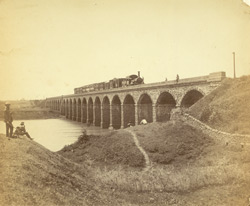Dapoorie Viaduct

The Dapoorie Viaduct was completed in 1858 by the Great Indian Peninsula Railway(GIPR) and was a vital section from Khandala to Poona of the mainline to link to Madras [2]].
It was one of the early major railway bridge to be constructed and comprised 22 stone arches of about 33 feet (10M) each span [3].
The masonary arches could only span short distances and required many piers [4].
References Note :-
Three of the References cited beow incorrectly state that the Dapoorie Viaduct 'carried the GIPR railway from Thane on Bombay Island to the Indian mainland'.
These References being:- British Library Photograph caption and paragraphs in the two books cited.
It was the Tannah Viaduct, opened in 1854 that connected Bombay Island to the mainland.
External links
- Photographs by T. Shepherd of Poona from the Faviell Collection of Ceylon Railway views, University of Cambridge Digital Library.
- Darporee Viaduct. View from one side of the line looking along the viaduct, a 22 arch stone bridge built by the G.I.P.R.
- The Viaduct and old Bridge [Darporee] View showing the other side of the viaduct, with part of the old wooden road bridge visible beyond.
References
- ↑ Dapoorie Viaduct from British Library "On-line Photograph Collection" - "Dapoorie Viaduct"; Retrieved 29 Jun 2016. A comment added advises that today the area is known as Dapodi, a suburb of Pune (Poona).
- ↑ Wikipedia "Great Indian Peninsula Railway - The Sahyadri crossed"; Retrieved 29 Jun 2016
- ↑ Google Books “ The Making of India: The Untold Story of British Enterprise” by Kartar Lalvani, page 326”; Retrieved 29 June 2016
- ↑ Google Books “Engines of Change: The Railroads that Made India” by Ian J. Kerr, page 48”; Retrieved 29 June 2016